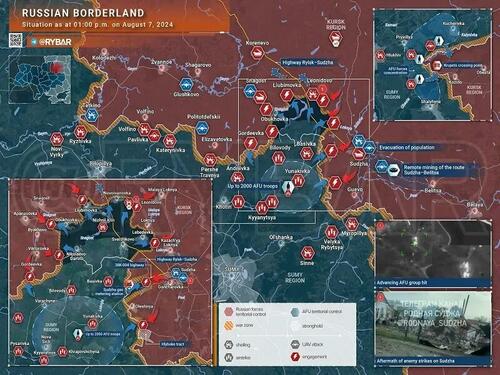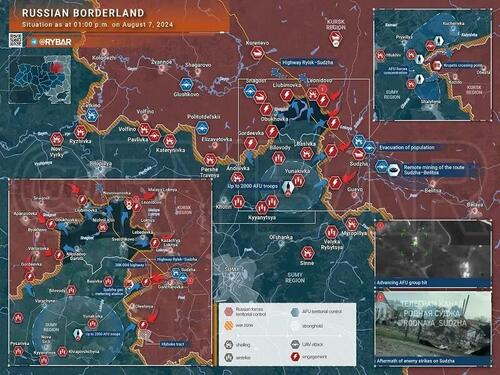Ukraine’s Sneak Attack Against Russia’s Kursk Region Might Be Its Last Hurrah
Authored by Andrew Korybko via substack,
Russia is fighting to fend off Ukraine’s sneak attack its Kursk Region, though conflicting reports have emerged about the location of these clashes. The Russian Defense Ministry claimed that all the fighting has taken place on the Ukrainian side of the border, while Rybar – which boasts nearly 1.2 million subscribers and functions as a think tank of sorts – said that it’s taking place inside of Russia’s borders.
Whatever the truth may be, this latest development is still immensely important.
Simply put, it might be Ukraine’s last hurrah since it represents a massive gamble to open up a new front inside of Russia’s pre-2014 borders with the intent of having its foes redeploy some of their troops to Kursk from Donbass, where they’ve continued gradually gaining ground this year. Russia had hitherto braced for yet another attack against neighboring Belgorod Region, ergo the difficult but necessary decision to impose a strict security regime there late last month, so it was taken by surprise.
Prior to that, there was serious concern that Ukraine might be preparing to launch an offensive into Belarus, which could have expanded the conflict and possibly served as a pretext for Polish involvement. Taken together in light of what just happened in Kursk Region, Ukraine’s moves in those two directions might have been meant in hindsight to “psyche-out” Russia, thus facilitating its latest attack. Unlike prior cross-border raids, this one also involves uniformed Ukrainian troops, not terrorist proxies.
Nobody took Ukraine seriously when it announced that it plans to launch another counteroffensive by sometime later this year, though what’s presently unfolding might be what its policymakers had in mind. That said, the scale isn’t anywhere near what last year’s failed counteroffensive was, and it’s not truly a counteroffensive since Russia wasn’t attacking Ukraine from Kursk. Nevertheless, it’s still the largest cross-border attack so far, and it was clearly planned for some time instead of being an impromptu raid.
These observations don’t imply that it’ll succeed, however, since the military-strategic dynamics have been trending in Russia’s favor for the entire year. After all, Ukraine is diverting limited troops and equipment from the Donbass front to the Kursk one, and this could easily backfire by creating an opening that Russia could exploit. Furthermore, they’re unlikely to hold whatever they might have captured in Kursk, thus precluding the possibility that they can “trade it back” during peace talks.
Even so, the very fact that what’s turned into a two-day-long battle at the time of this analysis’ publication could even happened in the first place shows that Ukraine still has some tricks up its sleeve, namely its continued ability to evade Russia’s surveillance, intelligence, and reconnaissance. Russia didn’t detect any notable buildup near Kursk’s border ahead of time, only Belarus’ and Belgorod’s, otherwise it would have launched preemptive strikes and imposed a security regime along the border.
That’s not to knock Russia but to draw attention to NATO’s impressive tactical capabilities in being able to successfully disguise its proxy’s sneak attack. This contributed to the growing number of civilian casualties that Russian Foreign Ministry spokeswoman Zakharova condemned as proof of Kiev’s terrorism. It might get a lot worse than even that before it gets better too if Ukraine is able to achieve a breakthrough in Kursk Region that leads to it threatening the eponymous nearby nuclear power plant.
The odds of that happening are low though according to Major General Apty Alaudinov, who’s the deputy chief of the Russian Armed Forces’ military and political department and commander of the Akhmat special forces unit according to TASS. Another point to make though is that Rybar’s earlier hyperlinked report claimed that Ukraine seized control of a gas pipeline transit station, which if true, could end up seeing that facility destroyed and thus cut off Russian gas to its Central European clients.
Kiev has an interest in punishing Hungary and Slovakia for their anti-war positions, hence why it recently sanctioned a Russian oil company that had an EU waiver to continue supplying those two, so it might accordingly want to inflict maximum damage against them by destroying the aforesaid gas facility. To be clear, Rybar’s report hasn’t been confirmed and might be untrue, but its importance and Alaudinov’s remarks about the nearby nuclear power plant rest in highlighting the huge stakes involved in Kursk.
For these reasons, it can be concluded that this was in the works for a while and is therefore likely to be Ukraine’s last hurrah, which it’s only attempting now out of desperation to receive some relief along the Donbass front where Russia continues to gain ground and might be on the brink of a breakthrough. Russia will likely soon regain its lost territory, if any has really been captured by Ukraine that is, and then make Kiev pay for this dastardly sneak attack.
Tyler Durden
Thu, 08/08/2024 – 02:00


